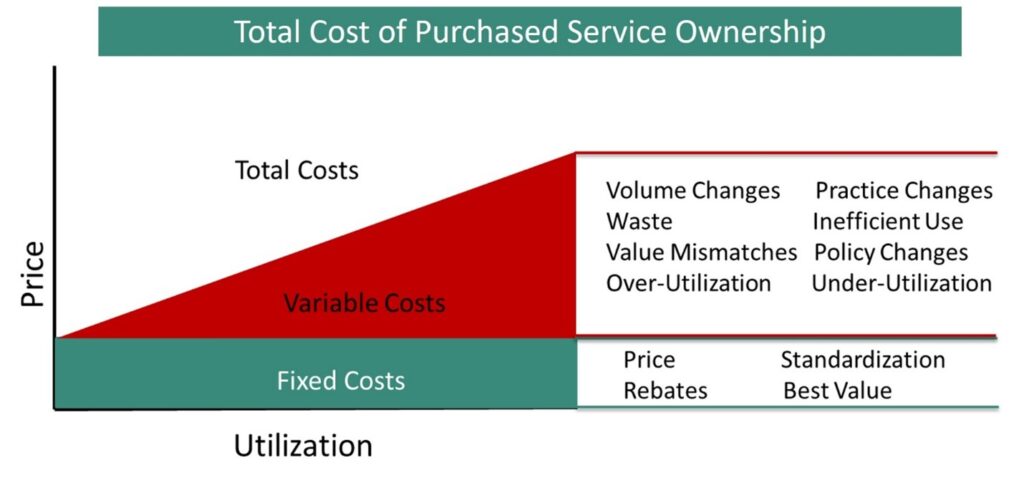Purchased service cost of ownership is often thought to be obtained when you obtain the best price for the contract under evaluation. However, price is just the tip of the iceberg as shown in figure 1 when you consider all of your contract’s variable costs compared to your fixed cost for a purchased service.
Figure 1

Just the other day, my team noticed that a client’s outsourced environmental services contract cost (year over year) jumped 23%, which wasn’t caused by a price increase that needed to be investigated. This is an illustration of why your fixed contract cost – price, rebates, standardization, and best value criteria – are the smallest cost components in your purchased service cost of ownership formula, and the reason your biggest purchased service savings opportunities are in your variable cost strategies that you need to replicate to reduce their total ownership cost.
Variable Cost Strategies You Need to Replicate
We always recommend to our clients that their first pass on a purchased service contract cost reduction should be reducing the price of their contracts under evaluation through competitive bidding. Next, we teach our clients that their biggest savings opportunities are in their variable cost strategies that they can employ to dramatically reduce their purchased services’ total cost of ownership. Here are the variable cost strategies you need focus on:
- Volume, Size, Capacity, and Quantity Changes: If the square footage cleaned under your environmental contract has been expanded without your knowledge, this could cause a growth factor in your cost that should warrant a price reduction. Unless you are measuring your year-over-year contract cost on each of your contracts, you will never pick up these contract volume creeps.
- Waste and Inefficiencies: If your laundry contractor is damaging and then replacing your linens and up charging you for their replacement, you might not notice this unless you track your linen cost per patient day in real time.
- Value Mismatches: Meaning, lower cost alternatives are available but you aren’t employing them. For example, having your own environmental staff water your plants and flowers vs. hiring a contractor to do so.
- Over-Standardization: This is the one-size-fits-all philosophy, when customization is the secret to saving money. For instance, do you need a daily trash pickup and cleaning of all of your hospital spaces? Maybe three times a week would be sufficient for many areas of your hospital, thereby reducing your contract cost.
- Practice Changes: If it is the practice of your nursing staff to return unused linens that they deem unacceptable, as was the case of one of our clients, you could be spending thousands of dollars a year for unnecessary rewash. By the way, our client resolved this practice by instituting more stringent quality controls in their client’s outsourced laundry.
- Policy Changes: One of our clients had a concierge policy that patient meals would be prepared and delivered after normal food service hours if requested, which was costing hundreds of thousands of dollars a year. Once this policy was changed these costs were dramatically reduced.
- Under-Utilization: Another client was subsidizing their coffee shop and cafeteria subcontractor by thousands of dollars annually because they were being under-utilized by their hospital staff and patient visitors. This problem was nullified by adding better signage in strategic places (better marketing) and encouraging the hospital staff to direct patient families to the cafeteria and coffee shop. Now this hospital makes a profit instead of subsidizing their contractors.
What should be obvious to you by reviewing these variable cost examples is that your purchased service contracts are living documents. Unless they are monitored before, during, and after you sign a purchased service contract, anything can happen to them that can change their cost, and usually does.
Purchased Service Contracts Are A Bird of a Different Color
One thing is for sure, purchased service contracts are different from commodity contracts and should be treated as such. If you think your job is finished once you bid and then award a purchased service contract, you are mistaken. It is just the beginning of a process to monitor the utilization of these contracts so they conform to your specifications, expectations, and aspirations. Otherwise, you could see your purchased service overall contract cost (not price) spiral out of control.
P.S. If you would like more information on this topic may I suggest that you e-mail me at [email protected] to obtain a copy of our “How to Rein in Your Multimillion Dollar Purchased Services Before They Damage Your Bottom-Line” e-book. It could make a real difference in how you save on your PS contracts.
Below are some similar articles that you may find interesting.
4 Big Purchased Service Missteps That Your Contract Team Should Avoid
